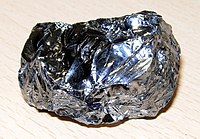
Photo from wikipedia
Abstract The Technology of Horizontal Silicate Barriers (TFHB) is an injection technology in which a solution of sodium silicate is introduced into the aquifer, close to the water table, while… Click to show full abstract
Abstract The Technology of Horizontal Silicate Barriers (TFHB) is an injection technology in which a solution of sodium silicate is introduced into the aquifer, close to the water table, while below CO2 is injected and catalyzes silicate gelation. Silicate gel decreases the aquifer permeability and forms a horizontal barrier. In this work, by means of geochemical modeling, we indicate potential interactions between silicate solution injected, and the rock-water system of an exemplary aquifer. Divalent ions may unfavorably accelerate silicate gelation. For this reason, to increase the gelation time, the alkalinity of the injected solution should be increased, or spacer fluids should be used. Under the analyzed conditions, a two-fold increase in the spacer fluid injection time causes a nearly six-fold increase in the gelation time. Changes in the pH induced by the injection of silicate to the aquifer disappear at a distance of 10 m from the wells in case of the use of the pre-treatment fluid, and 7 m without the spacer fluid. CO2 injected to accelerate the gelling, causes a pH drop in the aquifer to about 5.2. Changes in the mineralogical composition of the aquifer's primary rock matrix under the influence of TFHB are small, and alone, have no effect on the porosity.
Journal Title: Applied Geochemistry
Year Published: 2020
Link to full text (if available)
Share on Social Media: Sign Up to like & get
recommendations!